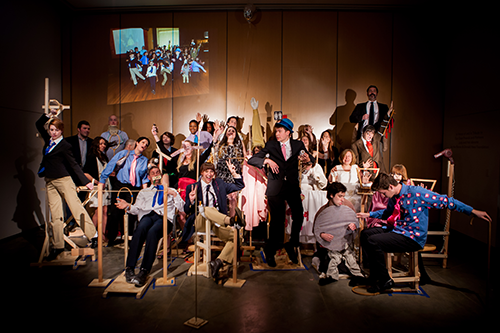The Prosthetics of Joy: Artist’s Introduction
(Performance, University of Alabama at Birmingham, March 21, 2014)
The Prosthetics of Joy is a live performance where the players, the set, and the costumes are indivisible. During the performance, a specific photograph I found on Facebook is reenacted and reconstructed from the inside out. The photo is of forty or so children at a party dressed like serious adults—in dark suits and fedoras—but in the midst of a unanimous and literal jump for joy.
In our reenactment, adults, who are supported in their exact mid-jump positions—including their airborne hair, beads, and neckties—by sculptural supports and rigid costume parts, play the children. These sculptural “prosthetics” were developed and custom-fit to the players’ bodies in the months leading up to the event, and incorporate found wooden objects, like embroidery hoops and wooden spoons, that give the structures a playful but urgent aesthetic.
Roll over either image below to magnify and compare detail
The play culminates in the exact moment of replicating the photo, and at that point, a second photo is taken from the same vantage point, but that moment is preceded by mini-narratives that are the result of the various players’ connections to their structural supports. (Two characters enter, seemingly on a summer date. One carries a badminton racquet, the other a helium-filled Mylar balloon. They have a playful exchange. Later, at “The Culminating Moment,” she raises the racquet and we see that her long curls are pinned to the mesh face of it in the same position as the original character’s tresses. He looses the balloon, and as it rises, it lifts one tuft of his hair into the same gravity-defying style of his child-counterpart.)
The Prosthetics of Joy celebrates the gaps in the translation from two-dimensional space back into three-dimensional space. For example, the lace pattern on one character’s dress constructed as a independent lace-like fabric made of hot glue that is suspended several feet in front of the character, lining up specifically with her body when viewed from the camera’s point of view. As a second example, we can only really see a small triangle of the golden necktie on the character in the second row, so it is played by a golden flame on a headband of the character in the first. In “The Culminating Moment,” they sync up.
By unfreezing the frozen photographic moment and refreezing it during the performance, this project toys with the huge gaps between the second, third and fourth dimensions. Through its elaborate and complicated process, it also speaks to the desire and the difficulty for us as adults to experience the unself-conscious and spontaneous joy that children can; it speaks as well to the elusive question of what happiness is actually supposed to look like. ![]()
Original photo by Siobhan O’Brien
Reenactment photo by Jared Ragland
The Prosthetics of Joy: Artist’s Introduction
Assembled Drawing
Drawings, Prosthetics, Exhibition Details, & Performers
Performing The Prosthetics of Joy ![]()
The Making of The Prosthetics of Joy ![]()
Acknowledgments

